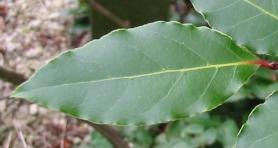Categories
Calendars
Guides
Reviews
Archive
Gallery
Articles
Ask Our Gardening Expert
Where to Grow Bay Laurel Tree
Bay Laurel Tree One of the most versatile herbs, Bay laurel can be grown as a tall evergreen
tree with its glossy foliage or in containers often as standard.
Hardy to around -7C. Another great advantage of a
container bay laurel is that it can be a houseplant in the
winter. The leaves are used in the French herb mixture 'bouquet garni' and
it is often used to flavour stews and meat dishes.
Want to buy a Bay Laurel?
CLICK HERE to go and buy your Bay
Laurel (UK only).
BAY TREE QUICK GUIDE Folklore Latin Name Type Site and Soil Plant to Harvest Time
Description
Several cultivars are commonly grown, including: 'Aurea', with
yellowish young foliage; 'Angustifolia' (also called willow-leaf bay),
with narrow lance-shaped leaves; and 'Undulata' with wavy leaf margins.
Where To Grow Bay
Where growing bay in a container, it is often best to bring them
indoors during the coldest three months of the year. A light, cool airy
room is best. Don't water very much during winter, let the compost
almost dry out before adding more water.
Known as laurel by the Greeks who wore it as a garland round
their heads. Also known as Bay laurel and Sweet bay.
Click
here
Laurus nobilis
Semi-hardy evergreen tree
Most positions although most vigorous in a sunny site, with lots of room for growth. Soil well drained,
well-dug and composted before planting.
2 years
The Bay laurel is a pyramid-shaped tree with aromatic, evergreen leaves
and shiny gray bark. It can reach 60 ft (18.3 m) in height in its native
conditions, but generally is much smaller, 3-10 ft (1 to 3 m) tall. The
leaves are elliptic, 3-4 in (8 to 10 cm) long, thick and leathery, and
shiny dark green. In Classical times the bay leaves were used to make
the victor�s �crown of laurels�.
 Small,
rather insignificant clusters of yellow, slightly fragrant flowers are produced in
spring. In autumn, on the female plants, green berries appear that ripen
to a dark purplish black.
Small,
rather insignificant clusters of yellow, slightly fragrant flowers are produced in
spring. In autumn, on the female plants, green berries appear that ripen
to a dark purplish black.
Most important for Bay laurel is their position. Especially in cold areas it requires a position sheltered from harsh
wind. Whilst Bay laurel will grow in shade, it is best suited to a sunny
position. It will
will grow on most soil types as long as it is well-drained.
Name: michel
E-mail: muddiewaterschal@yahoo.com
Date posted: July 04, 2011 - 09:31 pm
Message: why am i having such a hard time finding bay leaf trees
Name: Bettie Martin.
E-mail: nanabet@bluebottle.com
Date posted: May 31, 2011 - 04:01 pm
Message: Hi There, I have a Bay Laurel hedge which looks beautiful from the outside, but the inside of it is being eaten away by snails. Do you know what I can use to stop this. Many Thanks, Bettie Martin.
Name: margaret morrissey
E-mail: mgorrissey@gmail.comtm
Date posted: May 28, 2011 - 02:11 pm
Message: just transplanted my 5ft bay leaf tree from pot to the garden its leaves are turn yellowish and brown spots are appering. do i need to feed it phostrogen
Name: Patricia Best
E-mail: bestinternational@nycmail.com
Date posted: November 02, 2010 - 02:17 pm
Message: i would like to purchase 3 bay laurel trees Cell is 1917-392-1084
